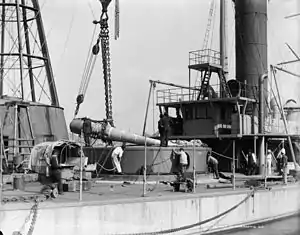10-inch/31-caliber gun
The 10"/31 caliber gun Mark 1 Mod 1 (spoken "ten-inch-thirty-one--caliber") and the 10"/35 caliber gun Mark 1 Mod 2 were both used for the primary batteries of the United States Navy's Amphitrite-class monitor Miantonomoh. The 10"/30 caliber gun Mark 2 was used as main armament on the remaining Amphitrite-class monitors, the monitor Monterey, and the armored cruiser Maine.
| 10"/31 caliber Mark 1 Mod 1/ 10"/35 caliber Mark 1 Mod 2/ 10"/30 caliber Mark 2 Naval Gun | |
|---|---|
 Fitting one of the 10-inch main guns to the front turret of USS Miantonomoh (BM-5) at the New York Navy Yard, circa 1890. | |
| Type | Naval gun |
| Place of origin | United States |
| Service history | |
| In service | 1890 |
| Used by | |
| Wars | |
| Production history | |
| Designer | Bureau of Ordnance |
| Designed | 1885 |
| Manufacturer | U.S. Naval Gun Factory |
| Unit cost | $38,566.58[1] |
| Variants | Mark 1 Mod 1, Mark 1 Mod 2 and Mark 2 |
| Specifications | |
| Mass |
|
| Length |
|
| Barrel length |
|
| Shell | 510 lb (230 kg) armor-piercing |
| Caliber | 10 in (254 mm) |
| Elevation |
|
| Traverse | −150° to +150° |
| Rate of fire |
|
| Muzzle velocity | 2,000 ft/s (610 m/s) |
| Effective firing range | 20,000 yd (18,000 m) at 15° elevation |
The Navy's Policy Board called for a variety of large caliber weapons in 1890, with ranges all the way up to 16-inch (406 mm). This 10-inch (254 mm) gun had been in development since 1885. The Navy desired a light weight heavy weapon with a 10-inch bore to arm their coastal monitors and the armored cruiser Maine, which would later be classified a "Second Class Battleship." The 10-inch/31 caliber gun would be the first heavy breech loader (BL) gun in the "New Navy" and be the ancestor to all large caliber BL guns built in the United States.
Mark 1
The 10-inch Mark 1 was a built-up gun constructed in a length of 31 caliber, Mod 0 and Mod 1, and also 35 caliber, Mod 2. These were both mounted in pairs on Mianonomoh and numbered 1–4 by the Navy. Both of the Mod 0 and Mod 1 guns had a tube, jacket, with the Mod 1 having a thicker jacket, and 15 hoops with a locking ring. The hoops started 5.91 in (150 mm) from the breech and extended to the muzzle. The Mod 2, was a 35 caliber gun of similar constructions but had only 14 hoops with a locking ring. These were all constructed of gun steel.[3]
Mark 2
The Mark 2 was an even simpler construction with only 11 hoops, a different breech mechanism and reverting to a shorter, 30 caliber length, barrel. Eighteen were built, Nos. 5–26. These would be the guns used on the remaining Amphitrite-class monitors, Monterey, and Maine.[3]
Naval service
| Ship | Gun Installed | Gun Mount |
|---|---|---|
| USS Miantonomoh (BM-5) |
|
Mark 1: 2 × Twin Turrets |
| USS Amphitrite (BM-2) | Mark 2: 10"/30 caliber | Mark 2: 2 × twin turrets |
| USS Monadnock (BM-3) | Mark 2: 10"/30 caliber | Mark 2: 2 × twin turrets |
| USS Terror (BM-4) | Mark 2: 10"/30 caliber | Mark 4: 2 × twin turrets |
| USS Monterey (BM-6) | Mark 2: 10"/30 caliber | Mark 2: 1 × twin turret |
| USS Maine (ACR-1) | Mark 2: 10"/30 caliber | Mark 3: 2 × twin turrets |
Surviving Guns
Two Mark 2 guns from USS Maine exist in Havana, Cuba, where they were incorporated into a memorial dedicated to victims of the ship's destruction.[4]
Notes
- Jamestown 1909, p. 101.
- Friedman 2011, p. 173.
- Spanamwar 2022.
References
- Books
- Final Report of the Jamestown Ter-Centennial Commission. Washington Government Printing Office. 1909. p. 101.
- Friedman, Norman (2011). Naval Weapons of World War One. Seaforth Publishing. p. 173. ISBN 978-1-84832-100-7.
- Online sources
- "United States of America 10"/31 (25.4 cm) Mark 1 Mod 0 and Mod 1 10"/35 (25.4 cm) Mark 1 Mod 2 10"/30 (25.4 cm) Mark 2". Navweaps. 25 July 2016. Retrieved 16 August 2016.
- "The Monument to the MAINE in Havana, Cuba". Spanamwar. Retrieved 6 December 2022.